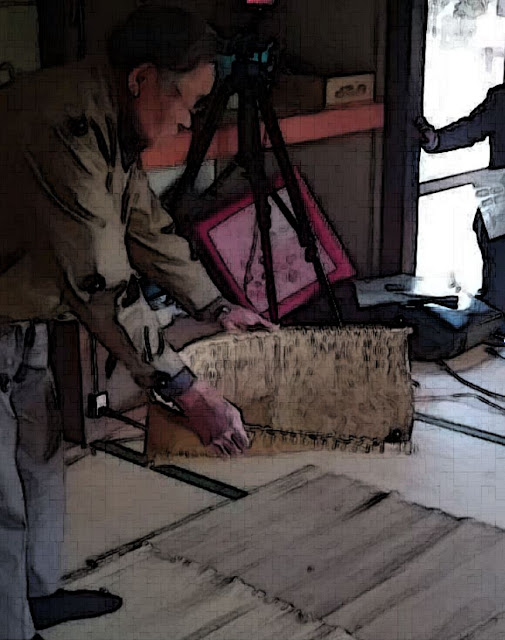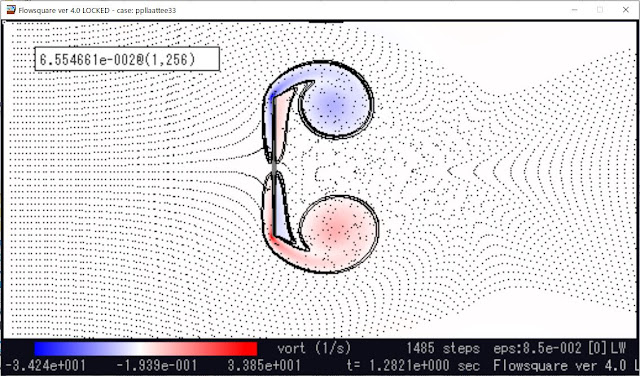軽く箕を振り下ろす瞬間、ミサキの中央辺りから勢いよく籾殻が飛び出します。その様子を示すために箕振りの動態測定用のビデオから取り出した画像に強調補正を加えてみました。
The moment a winnowing basket is being swung down lightly, rice husks leap out of around the center of the edge of the opening at the front of it. To show the moment, I added enhanced correction to an image out of a video for observing the movement of swinging a winnowing basket.
なかなか目立たないですが、背景の黒いコードが黄色く霞んでいる様子が確認できます。目視では、明確な吹き出しが確認できています。箕の振り始めに、軽くセットポジションに箕を置こうと上から下に移動した瞬間でもこの現象は確認できます。室内ですので背中からの追い風もなく、ほとんど無風の状態でも、この風は顕著に起きているようです。ここでは、この風の正体を探ってみようと思います。
You can confirm that the black cord in the background is blurred in yellow, although it is fairly inconspicuous. A visual inspection can confirm a clear blowoff. This phenomenon can also be confirmed at the moment when a winnowing basket is about to be moved downward to be placed lightly in a set position in the beginning of its swinging. It seems that this wind blows up noticeably even under an almost windless condition with no tailwind from the back in an indoor setting. In this blog post, I will examine what this wind really is.
吹き流しを付けてみました
I
attached a streamer to the winnowing basket.
二振り目です
The second swing
やはり軽く振り下ろすだけで箕の表面に風が起きているようです。ウデキの両サイドでは比較的大きな渦が、そして中央付近ではミサキに向かっての強い直進流が起きているようです。この理由は、直感的に、この箕の曲面によるものと考えましたので、箕を上から下に真っすぐ振り下ろすような状況を想定して、さらに、この現象を思い切り2Dに単純化した空気の流体解析を実施してみました。
It seems that a wind blows up again on the surface of the winnowing basket when it is just swung down lightly. It appears that a relatively large vortex comes up on both sides of the U-shaped frame tying a board-shaped structure made by weaving thin bamboo sticks made of the torn outer skin of thin straight bamboo and skinned Japanese wisteria and that a strong straight stream rises toward the edge of the opening at the front of the winnowing basket in the center of the U-shaped frame. My intuition led me to assume that this phenomenon could be attributed to the curved surface of the winnowing basket. That is why I conducted a fluid analysis of air based on a drastic two-dimensional simplification of the phenomenon on the supposition of the situation in which the winnowing basket is swung down straight downward.

横幅が1m程度の曲面を0.5m/sの速度で振り下ろしているような状況です
The above diagram illustrates the situation in which a curved surface about one meter wide is being swung down at a velocity of 0.5 meter per second.
通常の特性の空気によって満たされている空間に左側から一定の流速0.5m/sの空気の流れの中に、箕の2D断面を模した曲面を置いたものです。これだけでは、この空気の流れがいかなるものなのか、このコラムの冒頭の「ミサキ噴出」との関係はいかなるものなのかは分かりづらいので、比較として同じ大きさの板を準備してみました。
A curved surface shaped like the two-dimensional cross section of the winnowing basket is placed in an air flow at a velocity of 0.5 meter per second from left in a space filled with air with normal features. I prepared a board of the same size for comparison because this diagram is not enough to clarify what this air flow really is and how it is related to the eruption of the edge of the opening at the front of the winnowing basket mentioned in the beginning of this column.
横幅が1m程度の平板を0.5m/sの速度で振り下ろしているような状況です
The above diagram illustrates the situation in which a flat board about one meter wide is being swung down at a velocity of 0.5 meter per second.
曲面と平面では、流れを状況を示す粒子の状況が顕著に違うことが分かります。曲面であるか平板であるか以外は、まったく同じ条件でシミュレーションしていますので、この違いはなかなか面白いと思います。このことは、箕の底が平板だったら、あの箕振りの時のミラクルな「ミサキ噴出」は起こり難いということです。さらに、少し時間が進んだところで、ここで観察できる両サイドからの渦の状況を強調してみますと
The diagram shows noticeable differences in the state of particles showing the conditions of flow between the curved surface and the plane. These differences are fairly interesting because this simulation is under completely the same condition except for whether it is a curved surface or a plane. This means that if the bottom of the winnowing basket is a flat board, the miraculous eruption of the edge of the opening at the front of the winnowing basket when it is being swung will be difficult to occur. In addition, I highlighted the state of vortexes that can be observed from both sides after some time.
となっています。このシミュレーションの条件では、簡単に大きく違うとは言い難いですが、それでも顕著に曲面と平面との間で渦の巻き込み方、そのすき間を右から左に流れる、つまり通常の箕振りでは振り下ろした瞬間の下降気流となる流れが、箕曲面もどきと平面では全く異なることがわかります。
I got these two diagrams. It is difficult to say that there are simply large differences in the state of particles under the conditions of this simulation. But you can see noticeable differences between the pseudo-curved surface of the winnowing basket and the plane in the way the vortexes swirl and the flow in their opening from right to left, that is, a downdraft at the moment when a winnowing basket is being swung down in a normal way.
この2D流体解析でも、箕の曲面が、箕振り動作の際にきれいな空気の流れを生み、箕表面の圧力を生み、壁のない開放されているミサキ側に向かって空気の流れが生じ、その結果として「ミサキ噴出」が起きていると理解することはそれほど間違っていないようにも思えます。
In this two-dimensional fluid analysis as well, it seems that it is not so wrong to understand that the curved surface of the winnowing basket produces a clean air flow when it is being swung, that it produces pressure on the surface of the winnowing basket and that an air flow is generated toward the edge of the opening at the front of the winnowing basket that is open with no walls, which results in the eruption of the edge of the opening at the front of the winnowing basket.
大渦によるミサキ噴出のメカニズム
The mechanism of the eruption of the edge of the opening at the front of the winnowing basket by large vortexies
今、3D解析の準備中です。おそらく、3Dの解析においては、2Dで確認できた大渦の存在とそれに挟まれて起きる下降気流に加えて、アクドからミサキに向かっての直進流の発生が再現できれば完璧となると期待していますが、そうは簡単にその条件を見出すことはできないかもしれません。
I am now preparing for a three-dimensional analysis. I expect that it will be perfect in the three-dimensional analysis if I can replicate the generation of a straight wind from the stand-up part on the exact opposite side of the opening at the front of the winnowing basket to the edge of the opening at the front of the basket in addition to the existence of the large vortex that could be confirmed in the two-dimensional analysis and the downdraft that occurs in the vortex. But I may be unable to find such conditions so easily.
しばらく時間が空きましたが,実箕から読み取った3Dモデル(STL形式)からFLOWSQUARE+(https://fsp.norasci.com/index.html)を使って,箕を振り下ろした瞬間の空気の流れをシミュレーションしてみました。下図のように,振り下ろす代わりにミサキを下に箕を流路に立てて左側から空気を流し込み,箕面の底部に空気を当てています。
By
using a 3-D model (STL type) read from an authentic winnowing basket by
FLOWSQUARE+(https://fsp.norasci.com/index.html), I conducted a simulation of the air flow at
the moment when a winnowing basket is being swung down. As shown in the diagram
below, instead of swinging down a winnowing basket, I placed the winnowing
basket at the streaming space with misaki, the edge of the opening at
the front of the winnowing basket, placed below, ran air from the left, and
applied air to the bottom of the winnowing basket’s face.
すでに吹き流しでの簡易実験において,木積の藤箕を軽く振り下ろした瞬間のミサキからの空気の吹き出しは確認されているのですが,もう少しその箕の周りの空気の流れを見てみたいと考えました。シミュレーションの対象としては,当然ながらミサキの弾性曲線が美しい木積の藤箕と,その比較のためにミサキが直線的であるアジロ箕の阿波箕の2形態としてみました。
I
have already confirmed the streaming of air from misaki at the moment
when a winnowing basket made of Japanese wisteria’s bark in the Kizumi district
in Sosa City, Chiba Prefecture, is being swung down lightly in a simple
streaming experiment. But I wanted to look at the air stream around the
winnowing basket a little more. For my simulation targets, I chose a winnowing
basket made of Japanese wisteria’s bark in the Kizumi district whose misaki’s
elastic curve is beautiful and a wickerwork winnowing basket in the Awa
district in Tokushima Prefecture whose misaki is linear for comparison.
The distribution of the stream’s speed in the
direction parallel to the face of a winnowing basket made of Japanese
wisteria’s bark in the Kizumi district
上の図のグレーの物体が木積の藤箕の3DSTLの右側面(ミサキを前としての右)です。図中の黒い矢印は空気の流れの方向をその大きさとともに示したものです。カラーグラデーションは上下方向の流速を示していて,赤色ほど上昇気流,青色ほど下降気流であることを示しています。箕を振り下ろす代わりに,空気が静止した状態を初期状態として,左の端から,ここでは実際の箕振りのモーションキャプチャから得られた身体各部の動きを参考にして,流速0.3
m/sの右向きの空気を流し込んでいる状態です。上図は,空気の流入が始まってから約1.4秒後ぐらいです。箕を振り下ろして,宙に浮いた籾が箕面に再着陸して一呼吸付いたぐらいのタイミングでしょうか。The
gray object in the diagram above shows the right face (the right side with misaki
at the front) of the 3-D model of a winnowing basket made of Japanese
wisteria’s bark in the Kizumi district. The countless black arrows in the
diagram show the directions of air streams and their speed. Color gradations
show the speed of upward and downward air streams; the red parts show upward
air streams and the blue parts show downward air streams. The blue parts show
the directions of air streams from misaki.
I
set the left edge of Diagram 1 as an aperture where air comes in instead of
swinging down a winnowing basket. In this context, air clockwise of 0.3m/s runs
through according to the movement of each body parts based on the motion
pictures of swinging down a winnowing basket. The diagram above shows about 1.4
seconds after air starts to come in—about when chaff flies into the air and
lands on the face of the winnowing basket that was swung down.
ミサキ上空付近にきれいな渦が確認できます。比較のために,阿波箕も同様に,
You
can see a beautiful swirl between the red and blue parts around the right side
of misaki. For comparison, I did the same with a wickerwork winnowing
basket in the Awa district.
The distribution of the stream’s speed in the
direction parallel to the face of a wickerwork winnowing basket in the Awa
district.
示しますと,両者にそれほど大きな違いはないように見えます。しかしながら,ミサキの青色の強さとその上空の渦の強さには無視できない違いがあるようです。明らかに,木積の藤箕の方が強いように観察することができます。The
diagram shows that it does not appear that the two types of winnowing basket
are largely different. However, it appears that the difference between the
depth of the blue parts around misaki and the strength of a swirl on the
right side of misaki cannot be ignored. Clearly, the movement of air
around a winnowing basket made of Japanese wisteria’s bark in the Kizumi
district is stronger.
見る方向を変えて比較してみましょう。Now,
let me compare by changing directions.
Air streams around a winnowing basket made of Japanese
wisteria’s bark in the Kizumi district
Air streams around a wickerwork winnowing basket in
the Awa district
上が木積の藤箕でその下が阿波箕です。カラーグラデーションは上下方向(ミサキーアクドの縦方向)の流れで同じです。この角度から見ると,木積の藤箕の箕面中方からミサキにかけての青色が顕著に強いことが分かります。ウデキから入り込む渦の様子も異なり,明らかに強い空気の流れを見て取ることができます。The
diagram above shows a winnowing basket made of Japanese wisteria’s bark in the
Kizumi district and the diagram below it shows a wickerwork winnowing basket in
the Awa district. This perspective shows that the blue parts from the middle of
the face of a winnowing basket made of Japanese wisteria’s bark in the Kizumi
district to misaki are noticeably strong in comparison with a wickerwork
winnowing basket in the Awa district. The way a swirl runs into the face of a
winnowing basket is also different and you can see clearly stronger air
streams.
Air streams around a winnowing basket made of Japanese wisteria’s bark in the Kizumi district
Air streams around a wickerwork winnowing basket in the Awa district
さらに,阿波箕と木積の藤箕それぞれでのミサキからの吹き出しの流速の時間変化を比較すると,In
addition, I compared the time change in air streams from misaki with a
wickerwork winnowing basket in the Awa district and a winnowing basket made of
Japanese wisteria’s bark in the Kizumi district
The air stream’s speed around misaki
上図のようになり,それぞれの箕のミサキからの空気の吹き出し速度が顕著に異なることが読み取れます。この結果は,ミサキの縁に沿って中央部からウデキとつながるミサキの右端までの間に均等に3個のprobe(Flowsquare+上での検出器)を設置し得られたデータです。まだ2例ですが,箕の形状の違いによる吹き出し速度の違いは,意外と分かりやすく再現できそうです。これが実際に木積の藤箕と阿波箕それぞれを使用するときの実感覚での違いと同じであれば面白そうです。
このような箕の周りの空気の流れの違いは,箕の形に対応して顕著に異なることが期待できます。引き続き同じ方法で他の箕についても実施してみようと考えています
As
shown in the diagram above, you can see that the air stream’s speed from the misaki
of each type of winnowing basket is remarkably different. These results are
data gained by equally setting three probes (Flowsquare+ detectors) between the
middle part of misaki and the right edge of misaki, which is
linked with udeki, a U-shaped frame tying a board-shaped structure made
by weaving thin bamboo sticks made of the torn outer skin of thin straight
bamboo and skinned Japanese wisteria. I still got just two examples. But it
seems that I can easily reproduce the differences of air stream’s speeds by the
different forms of winnowing baskets. It seems interesting if these differences
are similar to the differences we sense when we actually use a winnowing basket
made of Japanese wisteria’s bark in the Kizumi district and a wickerwork
winnowing basket in the Awa district.
I
can expect that these differences in air streams around winnowing baskets
become noticeable according to the forms of winnowing baskets. I will continue
to test with other types of winnowing basket with the same methodology.

















コメント
コメントを投稿